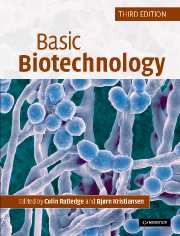Book contents
- Frontmatter
- Contents
- List of contributors
- Preface to the second edition
- Preface to the third edition
- Part I Fundamentals and principles
- Part II Practical applications
- Chapter 12 High-throughput screening and process optimisation
- Chapter 13 The business of biotechnology
- Chapter 14 Amino acids
- Chapter 15 Organic acids
- Chapter 16 Microbial polysaccharides and single cell oils
- Chapter 17 Environmental applications
- Chapter 18 Production of antibiotics by fermentation
- Chapter 19 Strategies of cultivation
- Chapter 20 Enzyme biotechnology
- Chapter 21 Recombinant proteins of high value
- Chapter 22 Insect and mammalian cell culture
- Chapter 23 Plant cell biotechnology
- Chapter 24 Biotransformations
- Chapter 25 Immunochemical applications
- Index
Chapter 23 - Plant cell biotechnology
Published online by Cambridge University Press: 05 June 2012
- Frontmatter
- Contents
- List of contributors
- Preface to the second edition
- Preface to the third edition
- Part I Fundamentals and principles
- Part II Practical applications
- Chapter 12 High-throughput screening and process optimisation
- Chapter 13 The business of biotechnology
- Chapter 14 Amino acids
- Chapter 15 Organic acids
- Chapter 16 Microbial polysaccharides and single cell oils
- Chapter 17 Environmental applications
- Chapter 18 Production of antibiotics by fermentation
- Chapter 19 Strategies of cultivation
- Chapter 20 Enzyme biotechnology
- Chapter 21 Recombinant proteins of high value
- Chapter 22 Insect and mammalian cell culture
- Chapter 23 Plant cell biotechnology
- Chapter 24 Biotransformations
- Chapter 25 Immunochemical applications
- Index
Summary
Introduction
Plants are the basis of all human activities: they serve us as foods and medicines; as a source of building materials, of fibres for clothes, of bulk chemicals (such as cellulose, amylose and rubber) and of fine chemicals (such as flavours, fragrances, insecticides and dyes). Consequently, since ancient times, people have been searching for new applications of plants and plant-derived products and have tried to improve the production of known products.
At the advent of biotechnology also, plants became an important target for biotechnological research.
The basis of all plant biotechnology applications is the totipotency principle. Totipotency means that every individual plant cell carries all the genetic information needed for all the functions of the plant and, in principle, should be able to grow out to a complete plant again.
Agrobiotechnology concerns the growth of plants as crops and aims at improving yields or changing traits connected with the quality of the plant. This can be done via the classical breeding approach, in which plant tissue culture has become a major tool that reduces the time of developing a new cultivar considerably, enabling the production of many identical plants in a short time. Molecular biology is the other major tool employed for improving plants. In this case, genes are overexpressed, giving a plant improved or new (and desirable) traits. For improving yields, the first generation of transgenic plants (genetically modified, GM) developed, overexpressed a gene that either made the plant herbicide-resistant or resistant against pests or disease.
- Type
- Chapter
- Information
- Basic Biotechnology , pp. 549 - 578Publisher: Cambridge University PressPrint publication year: 2006
- 1
- Cited by



